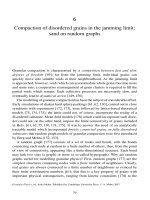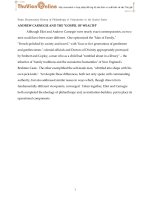Oxford history of art design in the USA
Bạn đang xem bản rút gọn của tài liệu. Xem và tải ngay bản đầy đủ của tài liệu tại đây (13.66 MB, 258 trang )
Design in the USA
Oxford History of Art
Jeffrey L. Meikle is Professor of American
Studies and Art History at the University of
Texas at Austin. He is the author of Twentieth
Century Limited: Industrial Design in America,
1925‒1939 (Temple University Press, 1979) and
American Plastic: A Cultural History (Rutgers
University Press, 1995), which was awarded
the Dexter Prize by the Society for the
History of Technology. His publications also
include numerous articles, catalogue essays,
and reviews. He has served as a consultant to
the Art Institute of Chicago, the National
Museum of American History, and the
Wolfsonian Foundation.
Oxford History of Art
Titles in the Oxford History of Art series are up-to-date, fully illustrated introductions
to a wide variety of subjects written by leading experts in their field. They will appear
regularly, building into an interlocking and comprehensive series. In the list below,
published titles appear in bold.
WESTERN ART
Archaic and Classical
Greek Art
Robin Osborne
Classical Art
From Greece to Rome
Mary Beard &
John Henderson
Imperial Rome and
Christian Triumph
Jas Elsner
Early Medieval Art
Lawrence Nees
Medieval Art
Veronica Sekules
Art in Renaissance Italy
Evelyn Welch
Northern European Art
Susie Nash
Early Modern Art
Nigel Llewellyn
Art in Europe 1700–1830
Matthew Craske
Modern Art 1851–1929
Richard Brettell
After Modern Art
1945–2000
David Hopkins
Contemporary Art
WESTERN
ARCHITECTURE
Greek Architecture
David Small
Roman Architecture
Janet Delaine
Early Medieval
Architecture
Roger Stalley
Medieval Architecture
Nicola Coldstream
Renaissance Architecture
Christy Anderson
Baroque and Rococo
Architecture
Hilary Ballon
European Architecture
1750–1890
Barry Bergdoll
Modern Architecture
Alan Colquhoun
Contemporary
Architecture
Anthony Vidler
Architecture in the
United States
Dell Upton
Native North American
Art
Janet Berlo & Ruth Phillips
Polynesian and
Micronesian Art
Adrienne Kaeppler
South-East Asian Art
John Guy
WORLD ART
Aegean Art and
Architecture
Donald Preziosi &
Louise Hitchcock
Early Art and Architecture
of Africa
Peter Garlake
African Art
John Picton
Contemporary African Art
Olu Oguibe
African-American Art
Sharon F. Patton
Nineteenth-Century
American Art
Barbara Groseclose
Twentieth-Century
American Art
Erika Doss
Australian Art
Andrew Sayers
Byzantine Art
Robin Cormack
Art in China
Craig Clunas
East European Art
Jeremy Howard
Ancient Egyptian Art
Marianne Eaton-Krauss
Indian Art
Partha Mitter
Islamic Art
Irene Bierman
Japanese Art
Karen Brock
Melanesian Art
Michael O’Hanlon
Mesoamerican Art
Cecelia Klein
Latin American Art
WESTERN DESIGN
Twentieth-Century Design
Jonathan Woodham
Design in the USA
Jeffrey L. Meikle
Nineteenth-Century
Design
Gillian Naylor
Fashion
Christopher Breward
PHOTOGRAPHY
The Photograph
Graham Clarke
American Photography
Miles Orvell
Contemporary
Photography
WESTERN SCULPTURE
Sculpture 1900–1945
Penelope Curtis
Sculpture Since 1945
Andrew Causey
THEMES AND GENRES
Landscape and Western
Art
Malcolm Andrews
Portraiture
Shearer West
Eroticism and Art
Alyce Mahon
Beauty and Art
Elizabeth Prettejohn
Women in Art
REFERENCE BOOKS
The Art of Art History:
A Critical Anthology
Donald Preziosi (ed.)
Oxford History of Art
Design in the USA
Jeffrey L. Meikle
1
1
Great Clarendon Street, Oxford ox2 6dp
Oxford New York
Auckland Bangkok Buenos Aires Cape Town
Chennai Dar es Salaam Delhi Hong Kong Istanbul Karachi
Kolkata Kuala Lumpur Madrid Melbourne Mexico City Mumbai
Nairobi São Paulo Shanghai Taipei Tokyo Toronto
and associated companies in Berlin Ibadan
Oxford is a registered trade mark of Oxford University Press
in the UK and in certain other countries
© Jeffrey L. Meikle 2005
First published 2005 by Oxford University Press
All rights reserved. No part of this publication may be reproduced,
stored in a retrieval system, or transmitted, in any form or by any means,
without the proper permission in writing of Oxford University Press.
Within the UK, exceptions are allowed in respect of any fair dealing for
the purpose of research or private study, or criticism or review, as permitted
under the Copyright, Design and Patents Act, 1988, or in the case of
reprographic reproduction in accordance with the terms of the licences issued by
the Copyright Licensing Agency. Enquiries concerning reproduction outside
these terms and in other countries should be sent to the Rights Department,
Oxford University Press, at the address above.
This book is sold subject to the condition that it shall not, by way of trade
or otherwise, be lent, re-sold, hired out or otherwise circulated without
the publisher’s prior consent in any form of binding or cover other than
that in which it is published and without a similar condition including
this condition being imposed on the subsequent purchaser.
0‒19‒284219‒6
10 9 8 7 6 5 4 3 2 1
British Library Cataloguing in Publication Data
Data available
isbn 0‒19‒284219‒6
Picture research by Elisabeth Agate
Copy-editing, typesetting, and production management by
The Running Head Limited, Cambridge, www.therunninghead.com
Printed in Hong Kong on acid-free paper by C&C Offset Printing Co. Ltd
Contents
Acknowledgements
9
Introduction
11
Chapter 1
The Emergence of the American System, 1790–1860
19
Chapter 2
Art and Industry in the Gilded Age, 1860–1918
51
Chapter 3
Designing the Machine Age, 1918–1940
89
Chapter 4
High Design versus Popular Styling, 1940–1965
131
Chapter 5
Into the Millennium: Moving beyond Modernism
175
Notes
211
Further Reading
219
Timeline
226
Museums and Websites
233
List of Illustrations
237
Index
243
5
This page intentionally left blank
For Aidai, Anna, and Andrew
This page intentionally left blank
Acknowledgements
My interest in the history of design has been stimulated over the years
by discussions with Bob Bednar, Reggie Blaszczyk, Kate Catterall,
Sally Clarke, Christina Cogdell, Tim Davis, Carolyn Thomas de la
Peña, Joel Dinerstein, Dennis Doordan, Chris Fay, Robert Friedel,
Peter Hales, John Heskett, Wendy Kaplan, Nic Maffei, the late
Roland Marchand, Vicki Matranga, Shelley Nickles, Valerie Pearcy,
Glenn Porter, Ray Sapirstein, Penny Sparke, Randy Swearer, and
especially Victor Margolin. I appreciate the dedication of research
assistants Sarah Mullen and Vanessa Meikle, who read through the
complete run of Industrial Design magazine. Vanessa, my daughter,
also offered a particularly insightful reading of the first draft of the
manuscript. The earliest phase of this project was generously supported by a Fellowship from the American Council of Learned
Societies, a Summer Stipend from the National Endowment for the
Humanities, and a Faculty Research Assignment from the University
of Texas at Austin. Rusty Sealy kindly provided a place to work at a
critical moment. I’m grateful to colleagues at the Renvall Institute
of the University of Helsinki who welcomed me as Bicentennial
Fulbright professor during the year I completed this book. On Oxford’s
production team, I want to thank Elisabeth Agate for her determined
tracking down of obscure images and David Williams for his superb
managing of all aspects of editing and design. As always, my wife Alice
was the best critic. She read each draft as an unwieldy manuscript
became shorter and—I hope—more to the point.
9
Introduction
Detail of 27
American materialism
The first inhabitants of North America dwelt in a natural landscape
shimmering with animistic significance. Each mountain, spring, or
waterfall projected an aura of primal force or mythic event. Europeans
who had settled the east coast in the seventeenth century violated this
aboriginal sense of seamless union with the natural world. In New
England, for example, colonists followed a grim Calvinist theology
that steeled them to wrest a livelihood from a ‘howling wilderness’.
They celebrated their success in subduing the land as a sign of God’s
favour. Other settlers later adopted the rationalism of Isaac Newton,
whom they thought had discovered the laws governing the movements
of God’s clockwork universe and, by extension, all of nature. The
North American continent seemed either a storehouse of material
resources ripe for exploitation or an empty Lockean tabula rasa waiting
for Europeans to write upon it, to build a new civilization. Whether as
Calvinist pessimists or Enlightenment optimists, the new Americans
perceived their material surroundings as a vast natural realm at their
disposal.
Some 150 years later, two revolutions coincided to shape the future
of US history and design. While the American Revolution established
a new type of democratic polity, the Industrial Revolution transformed
traditional social patterns of working and living. The explosive growth
of cities during the nineteenth and twentieth centuries separated
people from natural rhythms and landscapes, placed them in artificial
surroundings, and made them dependent on an increasing flow of
factory goods—some essential for survival, others intended for
comfort or delight, and all the result of planning by their designers and
makers. American democracy depended on design at a time when the
vision of a good life for everyone was becoming less spiritual and more
material.
Now, at the opening of the twenty-first century, the inhabitants
of the United States are enmeshed in artificiality. Americans cannot
escape continuous contact with the results of human design at every
scale—whether landscapes, cities, buildings, objects, or digital artefacts.
11
1 Chermayeff & Geismar
Pioneer section, ‘A Nation of
Nations’ exhibition, National
Museum of History and
Technology, Smithsonian
Institution, 1976
The open spaces and simple
artefacts of this gallery
reflected the austerity of early
American material existence.
2 Chermayeff & Geismar
Neon signs, ‘A Nation of
Nations’ exhibition, National
Museum of History and
Technology, Smithsonian
Institution, 1976
The exhibition’s final sections
emphasized the overwhelming
presence of visual
communications in the
twentieth century. An array of
signs for ethnic eating and
drinking establishments
recalled the diversity of
peoples who had settled in the
US since independence 200
years before.
Maintaining viable communities depends on systems of communication and transportation. Bodily nourishment depends on mechanized
farming and complex distribution systems. Daily life’s simplest physical and emotional satisfactions depend on an array of material and
digital products. The former blank slate of American nature has been
overwritten by a complex assemblage of artificial constructs—all the
result of rational processes of design.
The meaning of this continuing transformation emerges if we take
an imaginary tour of an exhibition installed over a quarter century
ago at the Smithsonian Institution in Washington, DC. ‘A Nation
of Nations’, the centrepiece of the museum’s celebration of the US
Bicentennial in 1976, documented the expanding artificiality of everyday life over two centuries. Visitors entered the exhibit in a darkened
passage devoid of material artefacts, lit only by an interactive map
whose pinpoints of light traced migration patterns of settlers of different nationalities—including African slaves, who had no choice in the
matter. Moving forward, visitors traversed a series of galleries, still
dimly lit, with objects scattered left and right [1]. The limited number
of these handmade things—wooden and iron tools, garments of linen
and wool, a crudely printed broadside—suggested the scarcity of
material possessions among colonists and pioneers. Continuing on,
figuratively entering the nineteenth century, visitors passed displays
ever more crowded with manufactured goods—an iron cooking stove,
tinware, pressed glass, ornamental ceramics, a sewing machine, watches
and mantle clocks, gaslight fixtures, a polished piano with ivory keys,
beaver hats, satin ribbons, brushes and combs of tortoiseshell and
celluloid, books and pamphlets, pens and pencils, daguerreotypes—
often arranged in furnished interiors suggesting the greater materiality
of everyday life.
As visitors approached the twentieth century, the arrays of artefacts
became denser. Their forms and materials were more varied, their
practical uses and status indicators more complex, offering evidence of
a quantum leap in the realm of the artificial. Electrical devices emitting light, sound, and visual images proliferated. Accelerating through
the final sections, ‘A Nation of Nations’ ended in sensory overload as
conflicting information media—phonograph, radio, movies, television, neon and acrylic signs, corporate logotypes—competed for
attention with a host of colourful products made of aluminium, steel,
chrome, rubber, and plastic [2, 3]. All this constituted the ephemeral
but still overwhelmingly material world of the Bicentennial present.
Even a casual visitor absorbed a sense of the material basis of American life. Additional reflection brought an awareness of the degree to
which the democratic pursuit of happiness was related to an increasing
flow of material goods—all of them the products of design.
12 introduction
introduction 13
3 Chermayeff & Geismar
Commercial images, ‘A
Nation of Nations’
exhibition, National Museum
of History and Technology,
Smithsonian Institution,
1976
Familiar American commercial
icons in unfamiliar languages
indicated a process of
economic and cultural
globalization whose extent
probably surprised most
visitors in 1976. American
design has often involved
attempts to create—and
ultimately to export—a
national culture.
Defining design
No one is quite sure how to define design. Is it process or product? Is it
verb or noun? Is it a universal human endeavour or a response to particular historical circumstances? How should we consider it? Are we
passive or active in response to it? Design is a complex activity affecting almost everything we use, touch, look at, or listen to. It shapes
objects at every scale of the material environment, however large or
small—toothbrushes and automobiles, microchips and medical scanners, building materials and planned communities, personal websites
and the Internet that connects them. Such phrases as ‘designer jeans’
evoke superficial elements of style, while philosophical meditations on
design often begin with prehistoric tools and subsume centuries of
technological development under the rubric of design.
A more modest historical approach maintains that design emerged
during the Industrial Revolution. Before then, an artisan laboured
by hand to produce an object whose outline was set by tradition but
whose final form varied according to imperfect materials, minor accidents in working the material, and a customer’s wishes. An artisan’s
intention moved from mind’s eye through hand’s motion to the
shaping of a physical object. This simple process, involving minute
variations in oft-repeated motions under the intuitive direction of a
14 introduction
single individual, yielded to a more complex process when the factory
replaced the workshop, when production of a series of nearly identical
objects replaced the fashioning of unique artefacts. The task of planning or conceiving work was separated from the task of carrying it out.
A new type of worker, the designer, devised two-dimensional patterns
or three-dimensional prototypes to be copied by other workers using
precise machines. Unlike an artisan, who communicated directly with
individual customers, a designer guessed at the needs and desires of
distant customers and accommodated them only generally. While an
artisan received a direct reward from a satisfied customer, a designer
received an indirect reward, a wage from a factory owner whose goals
included minimizing costs and maximizing production as well as satisfying customers. The designer thus served two masters whose interests
did not always coincide.
Constraints are the essence of the design process. A designer must
integrate a complex set of often contradictory solutions when designing even the most ordinary object. A product’s mechanically functional
components must be arranged to operate efficiently with little waste of
energy and human effort. They must be manufactured of durable materials and arranged to require little maintenance. A designer must also
consider supply or manufacture of component parts and methods of
final assembly of a product, not to mention packing, packaging, and
retail display. Taken as a whole, the assemblage of parts must meet the
needs of a range of diverse bodies and minds. It must be easy to operate
and control, and remain safe during any conceivable use or misuse. As
if this were not already difficult, an artefact’s shapes, colours, and textures must not only suggest its functions but also appeal to an intuitive
aesthetic sense whose shifting fancies seek novelty as often as harmony.
Considering this web of conflicting requirements, a promoter of design
once defined the profession’s work as ‘intelligence made visible’.1
Many observers take design on its own terms without exploring
wider social or cultural significance. When they do place design in
historical context, they often view it uncritically as evidence of humanity’s progressive evolution. Design is considered as a means of extending rational control over human environments. According to the
philosopher Herbert A. Simon, for example, design is ‘concerned with
how things ought to be’. The historian Henry Petroski has speculated
that irritation and frustration provoke designers, who tweak things so
that they ‘do what they are supposed to do’. Taking a wider perspective,
the critic Ralph Caplan echoes this theory of ‘negative’ motivation
when he says that design ‘is the only way we have of coming to terms
with our own technology’. Designers ‘work to reduce alienation’ by
humanizing or domesticating the products of the machine. In the final
analysis, as the philosopher David Pye phrases it, ‘design is a matter of
imposing order on things’.2
introduction 15
However sensible such definitions of design may seem, however
useful for understanding the motives of designers and the immediate
results of their work, they ignore important questions: Whose order is
it that design imposes? For what purposes? And with what results?
Answers to these questions must be sought outside the design process,
in its relationships with larger historical structures and patterns. Most
general theories of design assume that design is unproblematic, that it
exhibits a universal trend towards greater rationality, and that it works
unambiguously for the betterment of humanity by easing the conditions of everyday life. However, such theories tend to be simplistic.
Because design itself proceeds from the Industrial Revolution, which
was one of the most significant and disruptive social transformations of
the past three centuries, understanding the workings of design requires
a historical interpretation. Paul Greenhalgh rightly claims the entire
‘history of objects’ as the domain of the design historian, encompassing ‘the way we make things, the way we consume them, and the
myriad of meanings they have for us’.3
Design and art
Such thoughts may seem to have little connection with the history of
art. In fact, many historians and critics caution against looking at design
in traditional art-historical terms, for example as a parade of such
creative individuals as Louis Comfort Tiffany (1848–1933), Raymond
Loewy (1893–1986), and Charles Eames (1907–78); or as a roster of
aesthetically great works (Tiffany lamps, Loewy’s teardrop pencil
sharpener, and Eames’s moulded fibreglass chair); or as a progression
of aesthetic styles (Art Nouveau, Streamlined Moderne, and High
Modern). Richard Buchanan, for example, ignores what he calls
‘poetics’ (defined as ‘the study of products as they are’) so he can focus
on ‘rhetoric’ (‘the study of how products come to be as vehicles of argument and persuasion about the desirable qualities of private and public
life’). And yet, those very qualities of design, largely commercial and
often pertaining to commodification, became the object of such significant late-twentieth-century art as the mass-produced silk-screened
soup cans of Andy Warhol (1928–87). At the same time, designers and
graphic artists applied techniques and motifs borrowed from so-called
fine art, rendering them more accessible and placing them in the
service of commerce, but also thereby opening them up to populist
uses and meanings never intended by their creators. The sociologist
Pierre Bourdieu refers to these two related processes when he describes
‘a systematic reduction of the things of art to the things of life’ and,
running in the opposite direction, ‘the stylization of life, that is, the
primacy of forms over functions’.4
It may have been an exaggeration to claim that ‘industrial design is
16 introduction
the art of the twentieth century’.5 All the same, millions of Americans
and others continue to seek aesthetic stimulation and emotional satisfaction through goods that are designed and manufactured not only to
provide such fulfilment but also to meet functional needs and to yield
capitalist profits. The purpose of this book is to trace the history of
design in the US as a functional tool, as an economic force, and as the
expression of a consumer culture that continues to transform everyday
life. While always remaining aware of the full extent of design, our
attention will focus on the vast array of commercially produced objects,
most intended for personal use, which over time have made up an ever
increasing component of the material world.
introduction 17
The Emergence of
the American
System, 1790–1860
1
Detail of 20
During the earliest English settlement of the eastern seaboard in the
1600s, many colonists understood their lives as ruled by an overarching
‘design’. Most extreme in this regard were the New England Puritans,
who regarded themselves as God’s chosen people and sought to build a
spiritual ‘city upon a hill’. Even in Virginia, settled for commercial
motives, the concept of a grand design proved compelling. Protesting
against imperial controls in the 1770s, Thomas Jefferson described a
tyrannical ‘design’ to rob colonists of traditional English liberties. If
God no longer directed events, then Enlightenment rationalists
assumed that conscious human intention must be shaping society’s
course. Nothing could happen by chance. Everything happened ‘by
design’. Such uses of the word design might seem unrelated to the
design of material artefacts, but there is indeed a connection. The
Puritans anticipated a spiritual redemption of the material realm,
counter to traditional wisdom which had held it to be unchanging and
unregenerate. Reacting likewise against the stasis of medieval society,
the patriots of the American Revolution sought to apply reason to
create a society open to political experiment and social change. Such
beliefs gave meaning to the experiences of ordinary men and women as
they made their livings in the New World. Americans were prepared
to participate actively in transforming the material environment—a
process that involved them in design at every turn.
The myth of colonial self-sufficiency
Most North American colonists of the seventeenth and eighteenth
centuries lived off the land as farmers. Even into the twentieth century,
long after manufacturing and commerce had claimed most workers,
many Americans continued to think of their nation as rooted in agriculture. But the self-sufficient, individualist yeoman farmer, famously
celebrated by Jefferson in 1787 as the sole guardian of national virtue
and independence because he remained free of debt and beholden to
no one, unlike the industrial workers of Europe, was mostly a myth.
Even during the earliest years of colonization, when few people lived
beyond a subsistence level, most depended on others in the colonies
19
and in Britain for material goods essential to survival or to self-respect.
Many colonists, especially in New England, eked out a living raising
foods for their own consumption. But New Englanders also harvested
raw materials such as furs, fish, timber, and pitch for trade with
Britain. Farmers in New York, New Jersey, and Pennsylvania produced
wheat for export to other colonies and to Britain. Self-reliance failed
most notoriously in the southern colonies, where planters relied on
African slaves for intensive labour required to grow tobacco, indigo,
and—later—cotton for export. In return, by 1750 the colonists were
receiving a steady stream of manufactured goods from Britain: iron
tools, hardware, nails, tinware, earthenware, glassware, pewter, window
glass, clocks, carpets, bolts of cloth, buckles, and buttons.
At first only wealthy merchants in the seaports or the wealthiest
southern planters could enjoy an array of imported goods. By the eve
of the Revolution, however, they had trickled down to a wider market
whose customers considered them no longer as luxuries but as necessities, or at least as things they could hope some day to possess—
in effect, as objects of consumer desire just out of reach. Although
the war disrupted foreign trade, citizens rushed to acquire imported
goods after peace was declared in 1783. The political leader Tench
Coxe (1755–1824) regarded this ‘madness for foreign finery’ as a ‘malignant and alarming symptom’.1 For him the solution was not the
individual self-sufficiency of Jefferson’s yeoman farmer but a national
self-sufficiency derived from domestic manufactures and the mutual
cooperation of trade. Coxe’s overheated rhetoric suggested a fear of
becoming too comfortably involved with the things of the material
world. This ambivalence coloured American perceptions of ‘finery’,
style and fashion, and—later—design. The work ethic of production
that marked American culture even into the twentieth century masked
a fear that people became weak and passive as they yielded to the
attractions of consumption.
Colonial Americans had lived simply, however, and many continued to do so after independence. Especially in rural areas or small
villages, they made many of their belongings at home, such as wooden
dishes and utensils, brooms, baskets, butter churns, troughs for kneading dough, washboards, simple furniture, spinning wheels and looms,
and rough linen and woollen cloth. But they also relied on craftspeople
or artisans as sources for many goods essential to even the simplest
lifestyle. Although the first colonists ground their own corn and wheat
by hand, in most districts there was a miller using water power to turn
large grindstones. Sawyers and their mills were equally important, as
were blacksmiths, carpenters, coopers, shoemakers, tanners, and eventually weavers, tailors, hatters, and cabinetmakers. Many artisans were
itinerant, stopping only long enough to satisfy local demand. Others
who could not survive by their craft alone earned much of their living
20 the emergence of the american system, 1790‒1860
through farming. Many villages supported several such individuals,
bartering their work for that of others and for agricultural produce.
In port cities like Philadelphia, Boston, and New York, a diversified
market economy developed by the mid-1700s. Specialized artisans
plied their crafts in response to expanding consumer demand. Rapid
population growth stimulated new construction, which gave employment to carpenters, masons, bricklayers, plasterers, and painters.
Woodworking was taken up by joiners, turners, carvers, cabinetmakers, wagon and coach builders, wheelwrights, and coffin makers.
A necessity like shoes evolved its own subsidiary division of labour:
tanners, curriers, and dressers to prepare the leather, last makers to
provide the wooden forms over which it was shaped, and heel makers.
Other artisans earned their living as candle makers, saddle makers,
silversmiths, clockmakers, engravers, printers, and, when social leaders
sought reassurance of their status, as portrait painters. In 1792 a British
visitor credited cosmopolitan Americans for being as advanced as
Britons in the pursuit of style. After declaring the ‘quick importation
of fashions from the mother country’ to be ‘astonishing’, he noted
‘that a new fashion is adopted earlier by the polished and affluent
Americans, than by many opulent persons in the great metropolis’ of
London.2
This comment suggested that cultural independence did not immediately follow political independence. At least into the 1830s and 1840s,
when the rise of Jacksonian democracy coincided with the awakening
of romantic nationalism, most Americans looked across the Atlantic
for cultural guidance. But not everyone who sought to maintain appearances could afford furniture and tableware from Britain. Even many
among the wealthy had to accept furnishings made in America. With
city-dwellers pursuing the latest London styles, urban craftsmen satisfied the demand by directly copying imported goods or by borrowing
motifs from pattern books such as Thomas Chippendale’s Gentleman
and Cabinet-maker’s Director (1754). Chairs and cupboards made in
Philadelphia or New York eventually reached the provinces, where
they inspired local woodworkers to produce furniture that was meant
to evoke up-to-date style, though it only faintly echoed the original
British models.
Urban aspirations penetrated small towns and rural areas as fairto-middling folks demanded more and better things than the bare
necessities they had traditionally provided for themselves or obtained
from neighbours. Anecdotal evidence appeared in 1787 in a popular
magazine that described the marriage preparations of three sisters
living on a farm near Philadelphia. The eldest, married in 1780, had to
spin the family’s best wool and flax to make her own shifts, stockings,
and gowns. Two years later, however, the mother travelled to Philadelphia to buy her second daughter ‘a calico gown, a calamanco petticoat,
the emergence of the american system, 1790‒1860 21
a set of stone teacups, a half-dozen pewter teaspoons, and a teakettle’—none of which the mother had ever possessed. Three years
after that, the youngest received ‘a silk gown, silk for a cloak, a lookingglass, china, tea-gear, and other finery’.3 Far from being coerced to
consume things they did not need, this Pennsylvania farm family—
and thousands of others like them—hungered for material goods and
actively sought them out. The last thing they wanted was the selfsufficiency of Jefferson’s archetypal yeoman.
This rising consumer demand generated social and economic pressures that transformed the material conditions of everyday life in the
early nineteenth century. The process of making things changed as
traditional craft methods evolved into machine-based factories staffed
by unskilled labour. The process of acquiring things changed as warehouses, retail shops, and networks of peddlers replaced the traditional
face-to-face meeting of artisan and customer. Developing unevenly
here and there, these new forms of production and consumption
comprised an ‘American System’ so unprecedented that a visiting delegation of British engineers in the 1850s coined that phrase to refer to
it. Mediating between production and consumption, though no one
knew quite how to talk about it, was design. Confronted with the
challenge of satisfying a faceless multitude, makers and sellers of
manufactured goods began to pay attention—at first naively and awkwardly—to appearance, attractiveness, and appropriateness. From the
outset, design thus involved a confusion of motives. An emphasis on
more than simple function suggested that design addressed a democratic people’s desire not only to emulate those of higher social status
but also to outshine them.
From craft to mechanized production
More than any other factor, the great western migration across the
continent—a chaotic influx of varied peoples—determined the material parameters of everyday life in the United States. Between 1790
and 1860 the population increased from nearly four million to more
than 31 million. At the same time population density more than
doubled as people gravitated towards towns and cities where they
rubbed elbows with diversity, aspired to possess more than they could
personally make, and learned how to put on the appearance of
enhanced social status in fluid, impersonal situations. An expanding
population stimulated consumer demand for manufactured goods,
challenging producers to devise innovative methods for supplying
an ever higher volume of products. Unlike population growth in
Europe, which was constrained by enclosed land, entrenched aristocracies, and relative scarcity, American growth during the early
nineteenth century was surrounded by abundance and optimism. New
22 the emergence of the american system, 1790‒1860
households required a steadily increasing supply of furniture, housewares, domestic tools, and farming implements. As if rising consumer
demand were not challenging enough for artisans and craftspeople,
they also suffered an acute labour shortage. Farming attracted young
men who would otherwise have entered apprenticeships and siphoned
off skilled European immigrants who abandoned craft training to seek
fortunes in the fertile soil of Ohio or Illinois.
Struggling to overcome labour shortages and meet runaway consumer demand, artisans and entrepreneurs devised the manufacturing
side of the American System. For an individual manufacturer, the
challenge was to produce a greater number of things—guns, clocks, or
chairs, for example—in a fixed period of time, using unskilled labour,
and without sacrificing the quality consumers expected. The solution
involved rationalizing the steps involved in manufacture and mechanizing as many as possible. In traditional craft production, a single
artefact took shape under the direction of a master craftsman who
personally carried out or guided his apprentices in carrying out a
series of operations involving different hand tools in a sequence that
varied considerably with each individual artefact. The American
System involved transferring these imprecise actions to a carefully
sequenced series of specialized machine tools (milling machines, drills,
presses, and lathes), each performing a single action so unvaryingly
that it could be operated by a relatively unskilled worker, and so precisely that it yielded a series of nearly identical objects. The intuitive
intelligence of the craftsman yielded to the rational intelligence of the
mechanic who organized the precise, repetitive motions of a series of
machines [4].
The logic of this new organization of work emerged over the first
decades of the nineteenth century. For many years, historians traced
the American System to Eli Whitney (1765–1825), who signed a contract with the US government in 1798 to supply 10,000 military muskets
within two years—an impossible task given the painstaking intensive
methods of a master gunsmith. To obtain the contract, Whitney
promised interchangeable parts so precisely machined that a working
musket could be assembled from pieces picked at random or from parts
of damaged muskets salvaged from a battlefield. This concept was so
attractive that the government tolerated delay after delay. The final
musket was not delivered until 1809. Despite Whitney’s claims, historians have proven he did not successfully produce muskets with
interchangeable parts. Nor did he fully shift from craft methods to a
series of machine tools, but his struggle pointed the way.
John H. Hall (1781–1841) finally made good on Whitney’s promise
in 1824 by delivering to the government 1,000 breech-loading rifles
with fully interchangeable parts. In designing his machine tools, Hall
developed a means of assuring precise dimensions as a part moved
the emergence of the american system, 1790‒1860 23
4 Thomas Blanchard
Blanchard lathe, 1822
This machine tool cut irregular
three-dimensional wooden
forms by following the shape
of a full-sized model. Only the
model required the attention
of an artisan who in shaping it
became the designer of a
prototype. Invented by
Blanchard (1788–1864) for
making gunstocks, the
Blanchard lathe was later
applied to oars, wagon wheel
spokes, shoe lasts, axe
handles, and other wooden
artefacts.
through a sequence of mechanical operations. The challenge was to
overcome a multiplier effect in which a minor dimensional imprecision
introduced by one machine became a major functional distortion when
amplified by subsequent operations of other machines. His solution
involved giving each piece of work a single register point at which it
was clamped to each machine tool in the production sequence. Each
tool thus started its work from the same fixed reference point, and Hall
avoided the cumulative effects of random errors.
Although interchangeability of parts was to transform industry in
the twentieth century, historians have exaggerated its significance to
nineteenth-century manufacturing. Such a degree of precision appealed
to government arms purchasers who could ignore high cost as they
sought reliable performance under rigorous conditions. However,
mechanics and entrepreneurs who expanded the American System to
such consumer goods as clocks, reapers, sewing machines, and bicycles
rarely sought interchangeability. Almost all manufacturers employed
workers called ‘fitters’ who filed each part to the tolerances required for
24 the emergence of the american system, 1790‒1860









